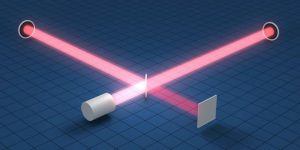Ethan Siegel in Forbes:
 Light always moves at the same, constant speed: c, or 299,792,458 m/s. That’s the speed of light in a vacuum, and LIGO has vacuum chambers inside both arms. The thing is, when a gravitational wave passes through each arm, lengthening or shortening the arm, it also lengthens or shortens the wavelength of the light within it by a corresponding amount.
Light always moves at the same, constant speed: c, or 299,792,458 m/s. That’s the speed of light in a vacuum, and LIGO has vacuum chambers inside both arms. The thing is, when a gravitational wave passes through each arm, lengthening or shortening the arm, it also lengthens or shortens the wavelength of the light within it by a corresponding amount.
This seems like a problem on the surface: if the light is lengthening or shortening as the arms lengthen or shorten, then the total interference pattern should remain unchanged as the wave passes through. At least, that’s what you would intuit.
But that’s not how it works. The wavelength of the light, which is highly dependent on how your space changes as a gravitational wave passes through, isn’t important for the interference pattern. What is important is the amount of time the light spends traveling through the arms!
More here.
